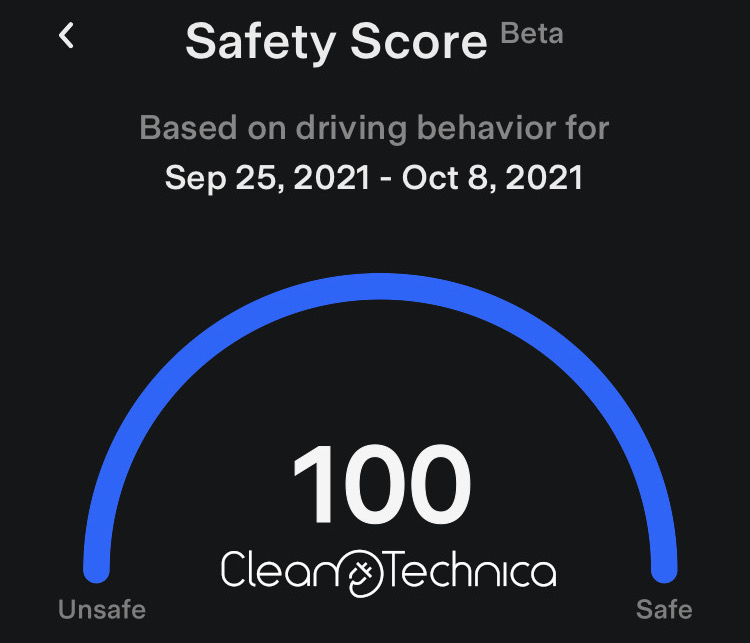
A new study from MarketWatch suggests that Tesla’s pioneering use of advanced telematics in assigning insurance risk may disrupt the insurance industry as much as the company has already disrupted global automotive markets. While many traditional insurance companies are raising rates for Tesla car owners or refusing to cover Tesla cars at all, Tesla is offering its own insurance in select U.S. states at significantly lower rates compared to the competition.
Variable Rates Based on Actual Driving Behavior
Based on a driver’s Safety Score, captured and calculated via Tesla’s own proprietary software, the company can assign risk levels to customers and offer lower rates to drivers the company considers less risky. The score looks at driving behaviors such as following distance, aggressive turning, hard braking, seat belt use, driving speed, and forced Autopilot disengagement to determine a score from 0–100. The higher the score for the driver, the lower the insurance rate.

Tesla Insurance relies on a driver’s Safety Score to set premiums in real-time based on driving behavior.
Tesla entered the insurance market in 2019 based on feedback that some of its customers were seeing much higher insurance costs for insuring their Teslas. Our own insurance was raised $1,000 annually by Liberty Mutual earlier this year, with no claims, no infractions, and no good explanation as to why. Unfortunately for us, Tesla insurance is not yet offered in New York.
Traditional insurance companies use the excuse that Tesla repairs tend to cost more than those for other automobile brands. And this is (or has been) true. With Tesla’s use of both aluminum and aluminum/steel alloys in its cars (to reduce weight), it has taken auto repair shops some time to come up to speed on how to perform repairs to Tesla cars. And this lack of Tesla-approved shops has also led to a certain amount of price gouging. In New York City, shortly after I purchased my first Model 3 in early 2018, there was only a single Tesla-authorized repair shop in the entire city. Now there are 27 Tesla authorized bodywork shops within a 15-mile radius of my home, some of which are within walking distance. Tesla has even opened its own body shops in select markets to handle simple fender benders, scrapes, and dents.
Recent Repair Pal data show that the average annual repair and maintenance cost of a Tesla is a bit higher than that of the average car ($835 vs. $652). However, this 28% higher average repair cost in no way justifies the actual increased premiums for Tesla vehicles, which can be more than double the cost of insuring other vehicles. The MarketWatch study looked at the average annual insurance cost of a Tesla Model S compared to other vehicles and found that a Model S costs (on average) $4,762/year for a 35-year-old driver with good credit and a clean driving record. The national average for insurance is less than half that, at $2,008. To be fair, this doesn’t take into consideration the cost of the car. With Model S average cost about $88,000 and the average new vehicle sold in the US closer to $48,000, the higher premium makes a little more sense. However, when compared to an EV at a similar price point (the Audio e-tron Quattro Premium, which starts at about $67,000), Tesla’s average insurance premium is still about 50% higher than the Audi’s, which costs around $3,200 to insure.
While other insurance companies such as Progressive and State Farm use third-party telematics devices or mobile apps to gauge insurance risk, none are as comprehensive as the sensors and software included in Tesla cars. The report suggests that Tesla’s success in the insurance market may exert price pressure on other insurers to compete, and may even provide incentive for other automakers to begin offering insurance as well. Both of these factors should provide downward pressure on the cost to insure Teslas and other EVs.
Is It Working?
Tesla promised when it launched its insurance program in 2019 that drivers could see savings of 20% to 30%. In reality, those discounts may be even higher. According to data compiled on the ValuePenguin insurance comparison web site, Tesla insurance rates are approximately 49% lower than the competition in Texas. That can represent a significant saving over the total life or total ownership of the car.
Other forces should also help to lower the average cost to insure a Tesla. Tesla vehicles have historically been on the higher end of the price spectrum. However, recent price drops have put both the Model 3 and Model Y below the national average price for new vehicles. The Model 3 currently starts at about $40,000 while the top-selling Model Y starts at just under $48,000 (both before incentives). Even the Model S recently got a price drop, with the entry level model now starting at under $75,000, and the Model X SUV is now down under $80,000. You can check current Tesla pricing on the Tesla website. Lower list prices mean lower replacement costs, and this (eventually) will translate to lower premiums.
The Catch?
Tesla Insurance is currently only available in 12 states. While Tesla plans to expand to more states over time, those of us outside the covered area are still at the mercy of traditional insurance companies. Tesla coverage is currently available in these states (as of September 2023):
- Arizona
- California
- Colorado
- Illinois
- Maryland
- Minnesota
- Nevada
- Ohio
- Oregon
- Texas
- Utah
- Virginia
Real-time rates based on the Safety Score are available in all of these states except California. In states that support the Safety Score variable rates, drivers can see their Safety Score in real time and will know immediately if their rates will increase or decrease in the following month. This “gamification” of insurance rates may be the most powerful part of the program. If drivers can see in real time what their driving style may cost them (and how much they can save by driving more defensively), then not only do drivers save money, but the roads actually become safer as well. And isn’t that the whole point?
Related reading:
Can Tesla Insurance Improve Driver Safety?
Here’s What $7,000 Damage Looks Like On A Tesla Model 3 (2018)
I don’t like paywalls. You don’t like paywalls. Who likes paywalls? Here at CleanTechnica, we implemented a limited paywall for a while, but it always felt wrong — and it was always tough to decide what we should put behind there. In theory, your most exclusive and best content goes behind a paywall. But then fewer people read it! We just don’t like paywalls, and so we’ve decided to ditch ours. Unfortunately, the media business is still a tough, cut-throat business with tiny margins. It’s a never-ending Olympic challenge to stay above water or even perhaps — gasp — grow. So …




